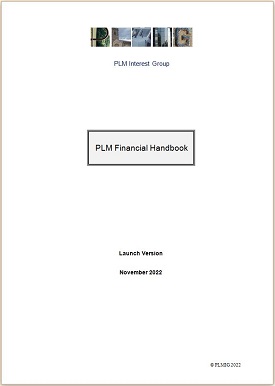|
PLM Interest Group |
|||||||||||||||||||||||||||||||||||||||||
|
|
|
|
|||||||||||||||||||||||||||||||||||||||
|
|
|
|||||||||||||||||||||||||||||||||||||||
|
|
|
|
|||||||||||||||||||||||||||||||||||||||
|
Monetize Your PLM
|
Monetize Your PLM
When you have achieved proper financial control of PLM, you will have the facts and figures to justify new projects and to show the benefits that are achieved as they are followed through.
It enables you to look at PLM in purely strategic terms, not just for product management but from a pure, high-level business point of view. At Board level, they look at how the corporation is structured; how the various divisions relate to each other and to the market; the future position the business is aiming for; and what needs to be done to enable this. When you have monetized your PLM, you can shape it to meet this vision of the business future. |
||||||||||||||||||||||||||||||||||||||||
|
Monetize Your PLM
|
Basic Financial Management
Everybody knows about project justification. It is the presentation of sufficient potential cost savings or financial benefits in any form so that the project is approved by the Board or by the relevant Approval Authority. For those who still believe that PLM is 'unquantifiable', then that in itself is an achievement. But proper financial management and control goes much further than that:-
Every major PLM implementation should achieve this level of Basic Financial Management if it is run properly. It should be considered as normal good practice. |
||||||||||||||||||||||||||||||||||||||||
|
Monetize Your PLM
|
Advanced Financial Management
Implementations that consider themselves to be among the best in the world should raise their horizons to the Advanced Level:-
It is likely that this will require a completely fresh look at PLM and the possibilities that it can provide for the business. The PLMIG provides the methodology and tools to guide you through this process. |
||||||||||||||||||||||||||||||||||||||||
|
Monetize Your PLM
|
Features and Benefits
Operating at this Advanced Level requires detailed collaboration between the PLM Team, the Finance Department, and a wide range of stakeholders. The PLM Team actively develops financial metrics and targets with all of the main departments, divisions and locations. Financial metrics are embodied within the accounting system, so that they are measured automatically as the company accounts are generated. The effects of this are that:-
Over time, this collaboration tends to become more and more positive and productive. |
||||||||||||||||||||||||||||||||||||||||
|
Monetize Your PLM
|
Methodology
There are two main parts to the Methodology:-
Advanced PLM Environment
Before anything else can happen there needs to be proper PLM Governance. There must be an active management structure that extends from the PLM Team up to the the Board, otherwise the high-level business planning decisions cannot be made. The PLM Governance Standard allows you to assess whether this is in place. There needs to be an agreed and published PLM Vision, to establish the direction in which PLM is heading; and this needs to be validated, so that it is clear that everyone understands and supports it. Thirdly, there needs to be a comprehensive working group or cadre that represents all of the business: departments, divisions, geographies, Sales, Marketing, Manufacturing, Quality, HR, Field Service, Purchasing, Customers and Suppliers. And finally, the hardest part - the PLM Team must have a proactive and detailed working relationship with the Finance Department. You have to understand how the Accounts are set up, what the accountants are doing, the difficulties they face and the ways that they can help. In most companies, the Finance Department is a distant area "behind closed doors". It require some care and effort to build this new relationship. Performing the Calculations
The complete methodology is contained in the PLM Financial Handbook, including the Analyis Algorithm and Metrics Algorithm that are used to run the calculations. However, the methodology is much more thorough and comprehensive than just two algorithms. It starts with Preparation, covering First Principles, Technical Issues, Management Issues, and how to mobilise. A 7-Stage process then moves from the Validated Vision through Reconstruction and Calculation to Management and Reporting; and on to Business Transformation, if that is the overall aim. By the time the process is complete, you will not only have the financial facts and figures for high-level and detailed planning, but you will know more about your implementation than you ever have before. Creating the Navigation Model, validating the Vision, producing the Maturity results, and internal benchmarking all produce facts and insights that enable much more accurate guidance for PLM. |
||||||||||||||||||||||||||||||||||||||||
|
Monetize Your PLM
|
PLM Financial Handbook
The PLM Financial Handbook contains everything you need for PLM financial management:-
All that is required is that the PLM Team applies the same level of effort and diligence to the methodology as it does to its everyday work. This is not a 'plug and play' activity - but then, neither is anything else in PLM. |
||||||||||||||||||||||||||||||||||||||||
|
Monetize Your PLM
Related Pages
|
Getting Started
The PLM Financial Handbook is an entirely self-contained document that contains the full methodology. It is provided as part of PLMIG Membership so that support is available as it is being used. The reason for this is that the methodology is at a very advanced level of PLM. It was produced over an 18-month timeframe by a series of 5 workshops run by the PLMIG, with participants from several different countries. This level of concentrated, iterated thinking has produced a very thorough and well-structured Handbook, but each user of the Handbook will start from a different PLM scenario. PLM environments that are advanced enough to monetize will always be complex, and monetization is to some extent transformational. There are likely to be "What If?" questions and issues that are best resolved by active Q&A, and this is what Membership provides. Find Out More
For more information about the PLM Financial Handbook, or advice on how to monetize PLM, contact monetizeplm@plmig.com. © Copyright 2025 PLM Interest Group |
||||||||||||||||||||||||||||||||||||||||
| <<< Return Home | |||||||||||||||||||||||||||||||||||||||||
|
|
|
|
|||||||||||||||||||||||||||||||||||||||
|
|
|||||||||||||||||||||||||||||||||||||||||






